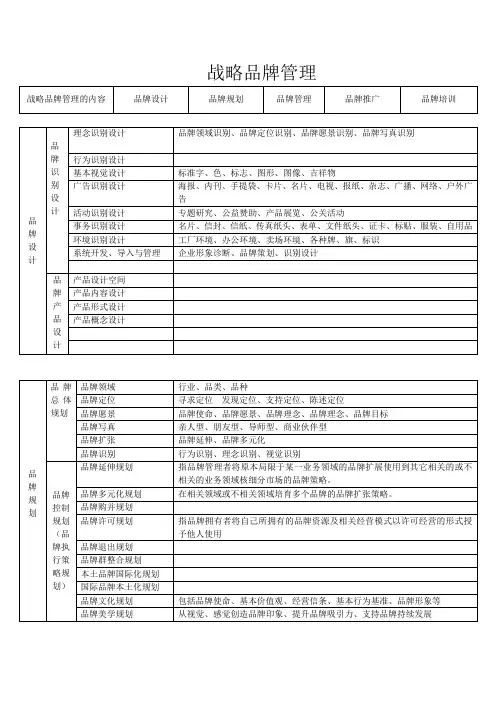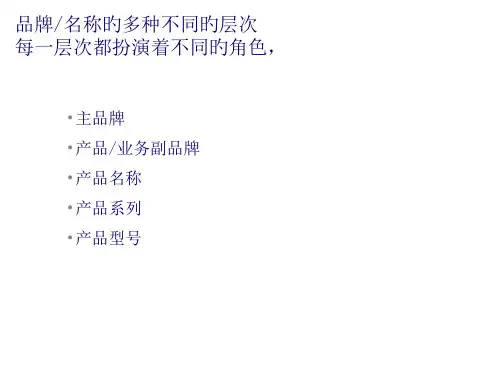- 1、下载文档前请自行甄别文档内容的完整性,平台不提供额外的编辑、内容补充、找答案等附加服务。
- 2、"仅部分预览"的文档,不可在线预览部分如存在完整性等问题,可反馈申请退款(可完整预览的文档不适用该条件!)。
- 3、如文档侵犯您的权益,请联系客服反馈,我们会尽快为您处理(人工客服工作时间:9:00-18:30)。
4.15
Characters
A special type of brand symbol—one that takes on symbol— human or real-life characteristics realSome are animated like Pillsbury's Poppin' Fresh Doughboy, Peter Pan peanut butter's character, and numerous cereal characters such as Tony the Tiger, Cap'n Crunch, and Snap, Crackle & Pop. Others are live-action figures like Juan Valdez live(Colombian coffee), the Maytag repairman, and Ronald McDonald. Notable newcomers include the AOL running man, the Budweiser frogs, and the AFLAC duck.
4.9
Tactics for Brand Elements
A variety of brand elements can be chosen that inherently enhance brand awareness or facilitate the formation of strong, favorable, and unique brand associations. Brand names URLs Logos and symbols Characters Slogans Packaging
4.2
Criteria for Choosing Brand Elements
Memorability Meaningfulness Likability Transferability Adaptability Protectability
Marketer's offensive strategy and build brand equity
4.7
Adaptability
The more adaptable and flexible the brand element, the easier it is to update it to changes in consumer values and opinions. For example, logos and characters can be given a new look or a new design to make them appear more modern and relevant.
The first dimension is an important determinant of brand awareness and salience; the second, of brand image and positioning.
4.5
Likability
Do customers find the brand element aesthetically appealing? Descriptive and persuasive elements reduce the burden on marketing communications to build awareness.
4.4
Meaningfulness
Brand elements may take on all kinds of meaning, with either descriptive or persuasive content. Two particularly important criteria
General information about the nature of the product category Specific information about particular attributes and benefits of the brand
4.17
Classic Slogans
"Melts in your mouth, not in your hands" (M&M's) "Sometimes you feel like a nut, sometimes you don't" (Almond Joy/Mounds) "Where's the beef?" (Wendy's) "A mind is a terrible thing to waste" (United Negro College Fund) "Can you hear me now?" (Verizon)
4.13
URLs
URLs (uniform resource locators) specify locations of pages on the web and are also commonly referred to as domain names. A company can either sue the current owner of the URL for copyright infringement, buy the name from the current owner, or register all conceivable variations of its brand as domain names ahead of time.
Brand associations
The explicit and implicit meanings consumers extract from it are important. In particular, the brand name can reinforce an important attribute or benefit association that makes up its product positioning.
4.6
Transferability
How useful is the brand element for line or category extensions? To what extent does thcross geographic boundaries and market segments?
Defensive role for leveraging and maintaining brand equity
4.3
Memorability
Brand elements should inherently be memorable and attention-getting, and therefore facilitate attentionrecall or recognition. For example, a brand of propane gas cylinders named Blue Rhino featuring a powder-blue powderanimal mascot with a distinctive yellow flame is likely to stick in the minds of consumers.
4.12
Brand Naming Procedures
Define objectives Generate names Screen initial candidates Study candidate names Research the final candidates Select the final name
4.10
Brand Names
Like any brand element, brand names must be chosen with the six general criteria of memorability, meaningfulness, likability, transferability, adaptability, and protectability in mind.
Source: Monty Phan, "Celebrating Their Sweet Success," Newsday, 21 September 2004, A43.
Brand knowledge structures depend on: The initial choices for the brand elements The supporting marketing program and the manner by which the brand is integrated into it Other associations indirectly transferred to the brand by linking it to some other entities
CHAPTER 4: CHOOSING BRAND ELEMENTS TO BUILD BRAND EQUITY
Kevin Lane Keller Tuck School of Business Dartmouth College
4.1
Building CustomerCustomer-Based Brand Equity
4.16
Slogans
Slogans are short phrases that communicate descriptive or persuasive information about the brand. Slogans are powerful branding devices because, like brand names, they are an extremely efficient, shorthand means to build brand equity




